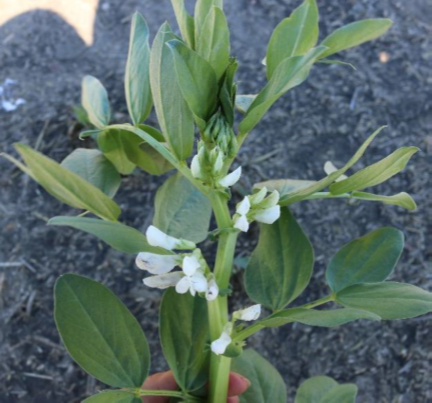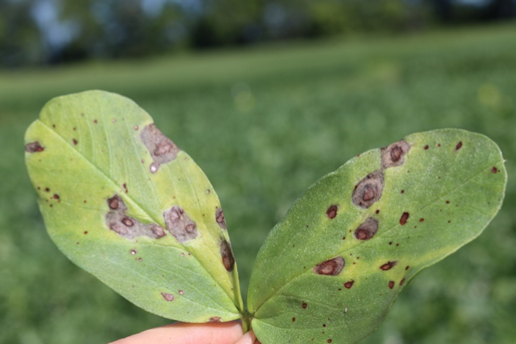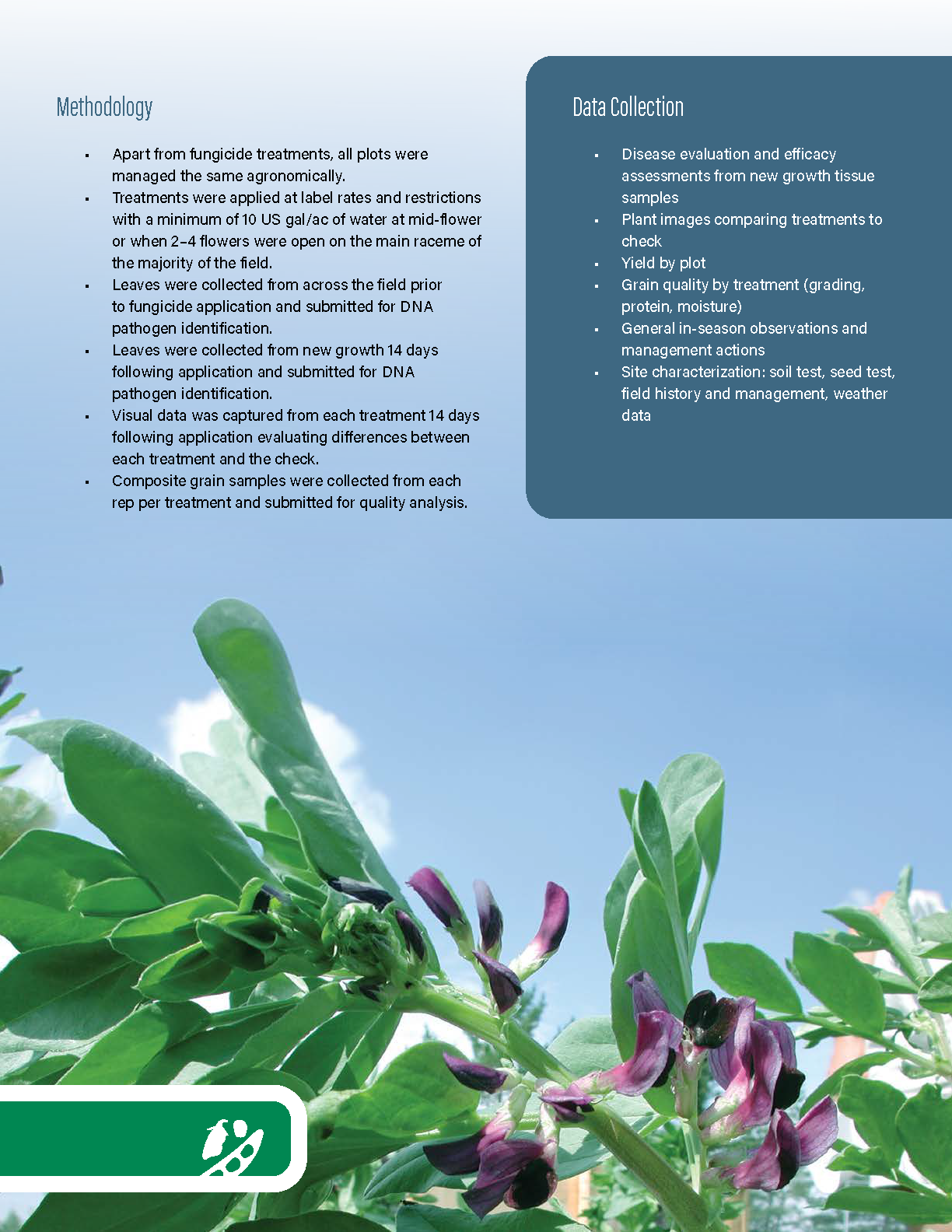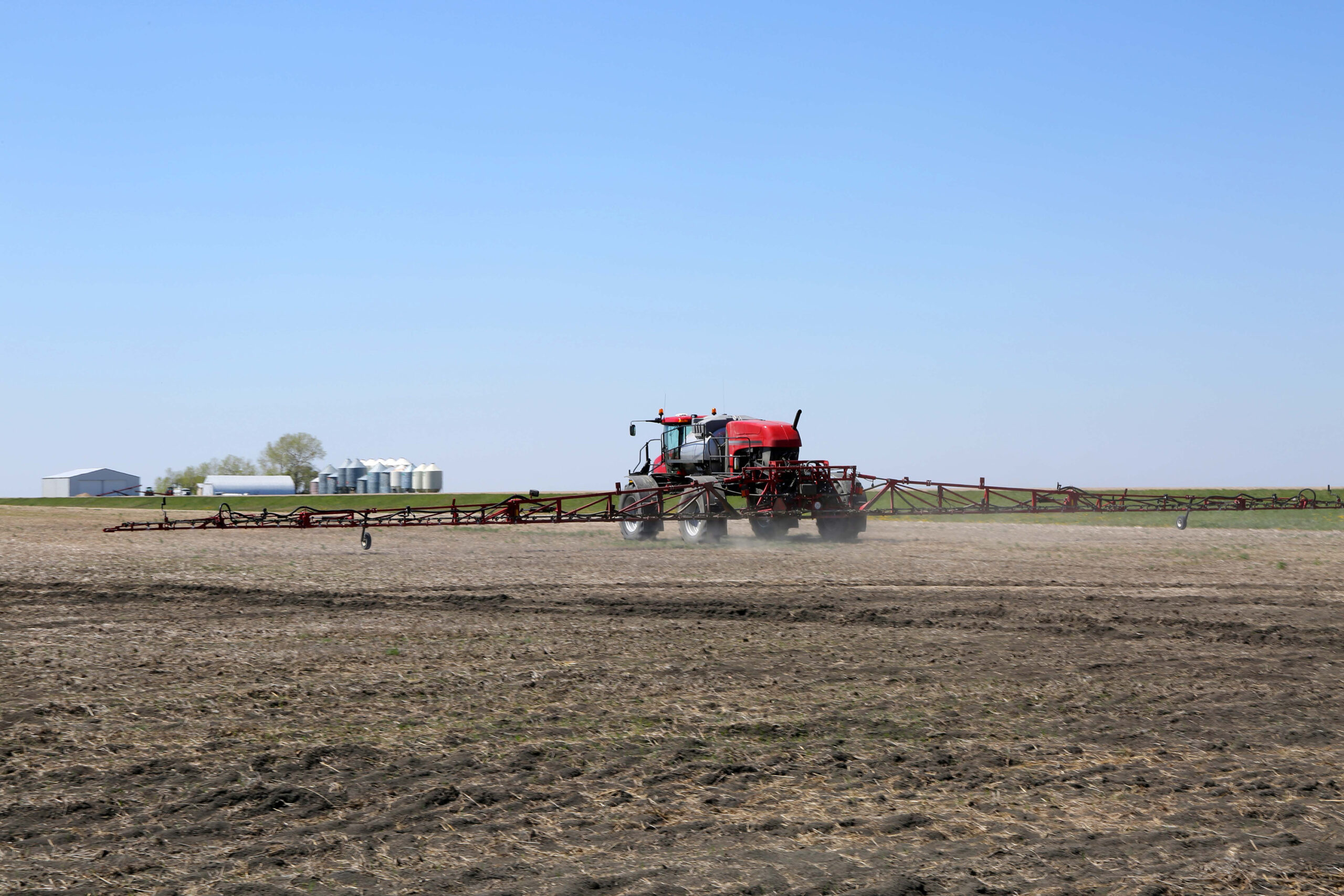Chocolate spot is the disease of most concern in faba beans grown in Western Canada, and is normally the result of infection with Botrytis fabae or Botrytis cinerea. Botrytis fabae is more destructive and in suitable conditions, the fungus can kill the plant in a few days. The related species Botrytis cinerea, a pathogen of lentils, can occasionally cause chocolate spot. It has generally been regarded as insignificant in faba beans, however, it was found at an unexpectedly high frequency in the 2017 survey of Saskatchewan faba bean fields. Recent pathogenicity research conducted by Chatterton et al., (2021) confirmed that disease severity caused by B. fabae was higher than B. cinerea when combined across all inoculum concentrations; however, in the greenhouse studies they usually caused generally the same level of disease, with some interaction of faba bean cultivar.
Chocolate spot is a concern in most cool to temperate faba bean growing regions around the world, such as Australia and Europe. In Australia, where faba beans are well established as a winter crop, chocolate spot is one of the major disease problems and is most aggressive under moderately warm temperatures and humid conditions, particularly at flowering time. In Europe, the crop is often predisposed to disease because of insect pests that are currently not a problem in Canada. However, damage from insects such as lygus bug and pea leaf weevil could predispose faba beans to infection, and could lead to quicker spread and high levels of infection. Research is underway evaluating the connections between these two insects and chocolate spot infection in Western Canada.
Disease Development and Severity
Disease development is highly dependent on environmental conditions with temperature, dew point, and relative humidity interactions being key criteria. The chocolate spot fungus thrives in moderately warm (15 to 20°C) and humid conditions (>70%). Field studies have indicated that cooler temperatures and wetter environments contribute to infectious periods of Botrytis spp. whereas elevated temperatures have a negative correlation to disease severity. Higher plant density is expected to be somewhat more susceptible, due to higher humidity within the canopy. Greenhouse experiments (Chatterton et al., 2021) revealed that duration of dew point temperatures and nightime conditions were even bigger factors contributing to disease severity than relative humidity. Dew point temperatures (5°C) for three hours and warm nighttime temperatures (10 to 15°C) resulted in the highest disease severity.
Severity also depends on when the infection starts. No predictive models or warning systems have yet been developed for Western Canada. Disease development early in the season or during flowering may cause more damage and result in large yield losses. Mid– to late- season infections, which are more often observed and correspond to low dew point temperatures (10 to 15°C), may cause little to no yield loss. Later season infections appear to have limited impact on yield, but can bring the crop in earlier, which in a late maturity crop can be regarded as beneficial. Evaluation of faba bean response to fungicide and the effect of fungicide timing are currently under investigation.
Disease Cycle
Botrytis can overwinter as sclerotia in the soil, in crop debris, and on seed. Seed with more than 10 per cent botrytis should not be used for planting. Seed treatments can control seed-borne botrytis. Spores produced by the fungus are spread by wind and rain splash within and between crops. Although leaf wetness alone is not an important component of disease development, moisture on the plant surface is required for spore germination and infection. The disease builds up rapidly under moderately warm, moist conditions. Once the disease becomes established, it spreads quickly in the crop and within four to five days of infection, spores can be produced on infected tissue, initiating secondary infection and further spread of the disease.
Symptoms and Scouting
Small brown coloured lesions appear first on leaves (Figure 1). The chocolate coloured lesions start small, but begin to expand and coalesce if moisture is available under warmer temperatures, eventually merging so that the whole leaf turns brown. After two or three weeks, the larger lesions will turn gray, looking similar to botrytis or gray mould in other crops. The disease does produce small sclerotia bodies similar to Sclerotinia sclerotium (white mould). The sclerotia bodies can be found inside the stems of badly diseased plants. Chocolate spot also damages the seeds, producing dark- coloured sunken lesions.


Chocolate spot lesions on lower leaves can be confused with other types of injury. Herbicide or surfactant burn (Figure 2) and frost damage can cause symptoms similar to larger lesions of chocolate spot, but are localized to the leaves exposed during time of application, or youngest tissues encountering freezing temperatures. The lesions also do not spread beyond the initial injury and often similar symptoms can be found on other plants within the field such as broadleaf weeds.
Control Options
Control options for chocolate spot include:
- Choosing the most resistant varieties
- Application of fungicide
- Planting good quality seed with low infection levels
Faba bean varieties available in Western Canada are not currently rated for susceptibility to chocolate spot and are all considered equal in susceptibility. Testing seed for disease levels prior to planting can help reduce the risk of infection at the seedling stage and early disease onset in a field, and should be considered when doing germination tests. Based on lentil recommendations, growers should use different seed if levels of botrytis on the seed are over 10 per cent.
Economic thresholds for fungicide applications have not been established for chocolate spot in faba beans. There are several research trials underway in Saskatchewan and Alberta comparing fungicide options, timing, and economic returns. Once researchers gain more information about the disease, including timing and economic returns, an economic threshold can be established to help growers make fungicide decisions.
There are several fungicides registered for use on faba beans, however few actually list control of botrytis or chocolate spot on the label. It is a relatively new disease and the research has not been done for all products, as faba bean acreage is still relatively small.
Timing and Application of Fungicide
In most pulse crops, fungicide applications are recommended early-to mid-flower, and before the canopy closes. Faba beans have a more erect growth habit and therefore a more open canopy, so growers can delay spray applications a bit further into flowering to assess their risk and determine whether or not a fungicide application is necessary.
Chocolate spot can cause flower abortion and reduced pod set if early infection occurs. Late infections may not affect yield as much as earlier infections, but can have a dramatic effect on seed staining and loss of quality. Seeds without disease staining and insect marks are considered high quality and may capture higher premiums, especially with types targeted for human consumption.
The majority of faba bean yield comes from pods of the middle flowering nodes, followed by pods from lower and upper flowering nodes. It is suggested that approximately the first five flowering nodes are the ones to protect if early disease infection is expected or evident. Faba beans are considered at full flower when there are flowers open on the first five flowering nodes or racemes. As with any disease, if the disease is present (symptoms of disease on leaves), conditions favour development (moisture and moderate temperatures in the forecast), and the crop is at susceptible stages (flowering and beyond), fungicide applications may be beneficial. Timing of fungicide applications is still being evaluated in Saskatchewan, but it is suggested that applications may be most effective at the mid- flowering stages, such as when flowers are open on two to four flowering nodes or racemes (Figure 3), when disease is present on the leaves, and if mild humid conditions with extended dew periods of 3 hours are forecast. If no disease is present and conditions are hot and dry, then likely no yield benefit will be gained from a fungicide application.
As with most diseases, it is important to protect healthy tissue. Once tissues become infected, there is no way to cure. As with all fungicide applications, use sufficient water volumes and drop size to ensure that the application provides good coverage and is able to penetrate into the canopy. Fungicides do not move within the plant the same way systemic herbicides do, so it is important to get good coverage to ensure fungicides have the best chance of providing protection to the plant tissues. Faba beans can become quite tall and robust (Figure 4) which can make canopy penetration challenging.





